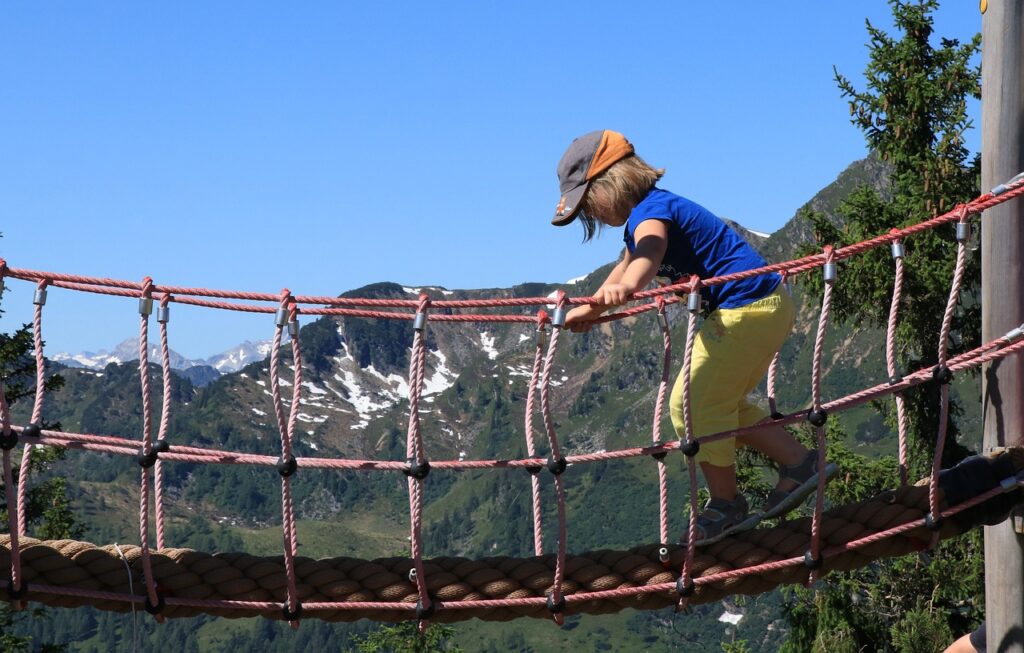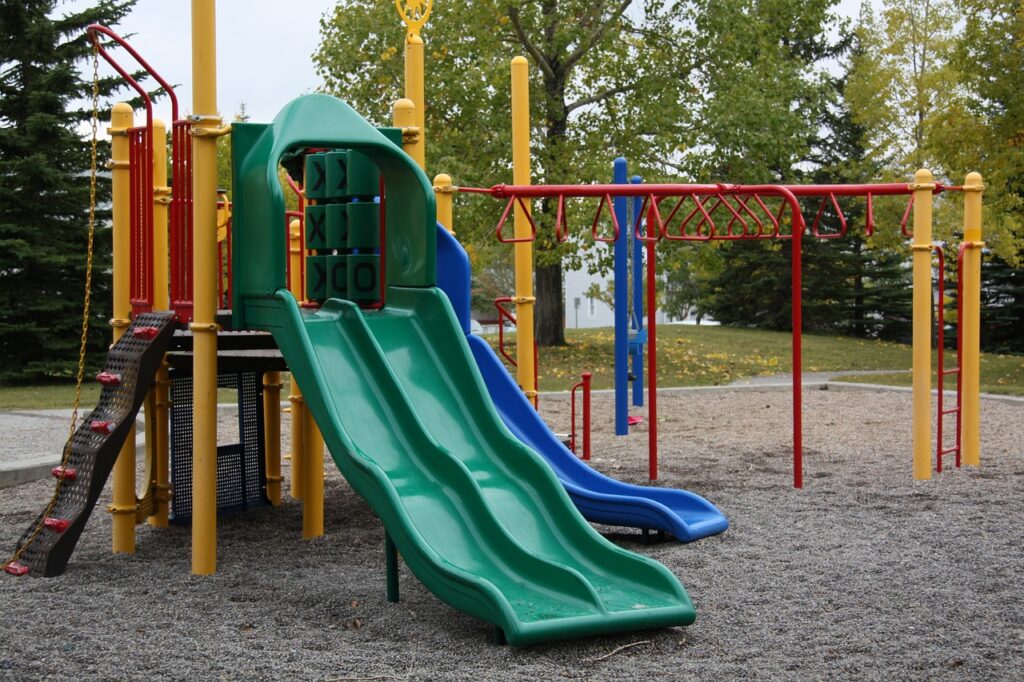Table of Contents
What is a Climbing Game?

Climbing games are fun and challenging activities that revolve around climbing as their primary focus. They come in various forms, from basic ladders and slides to elaborate obstacle courses and rock climbing walls.
Climbing games are an excellent way for kids to develop their physical and cognitive skills while having fun and exploring their surroundings. These games provide a broad range of challenges, from simple climbing and balancing to more complex maneuvers like traversing and swinging.
What’s great about climbing games is that they can be tailored to fit different ages and abilities. Toddlers can start with straightforward structures that are close to the ground and easy to navigate, while older children can take on more challenging obstacles that demand strength, endurance, and strategic thinking.
Apart from being fun and challenging, climbing games also offer many benefits for kids’ development. They help to develop gross and fine motor skills, coordination, and balance, as well as cognitive abilities like problem-solving and spatial awareness.
When it comes to safety, it’s crucial to choose age-appropriate and ability-level climbing games. Ensure that the structure is sturdy and secure and always supervise your child while they climb.
Climbing games provide endless opportunities for kids to challenge themselves, build confidence, and reach new heights while developing their physical and cognitive skills.
Whether it’s a simple backyard climbing structure or a more elaborate playground obstacle course, climbing games are an exciting and beneficial way for kids to engage with their environment and have fun.
Why Is It Important for Kids to Climb?

kids are naturally drawn to climbing, and for good reason! This innate behavior is hardwired into their brains and provides numerous benefits for their physical, cognitive, and emotional development.
Here are some reasons why kids climb:
1. Exploring their environment
Young children are naturally curious about the world around them, and climbing allows them to explore their surroundings in a unique way. Climbing gives them a new perspective on their environment and can help them learn about spatial relationships and depth perception.
2. Building strength and coordination
Climbing is a great way for kids to develop their muscles and improve their coordination. As they climb, they use their arms and legs to support and balance themselves, which can help build strength in their core, arms, and legs.
3. Boosting confidence:
Climbing can be a challenging activity, especially for younger children who are just learning how to do it. As kids successfully navigate climbing structures and games, they gain a sense of accomplishment and confidence in their abilities.
4. Fostering independence:
Climbing can be a way for children to assert their independence and show that they can do things on their own. By figuring out how to climb and exploring their environment, children develop a sense of autonomy and self-reliance.
5. Releasing energy
Finally, climbing is a great way for kids to burn off energy and release pent-up emotions. When children are able to climb and play in a safe and controlled environment, they are more likely to be happy and content.
Of course, safety is a top priority when it comes to toddler climbing. By understanding the reasons behind their climbing behavior and providing appropriate structures and supervision, parents and caregivers can ensure a safe and rewarding climbing experience for their little ones.
Climbing is a natural urge for young children, and it can have a host of benefits for their physical and mental development. As parents, it’s important to provide safe opportunities for kids to climb and explore their environment, while also being mindful of safety concerns.
By understanding the natural urge to climb and the benefits it provides, parents can help their children develop into strong, confident, and independent individuals.
Benefits of Climbing in Early Years

Climbing is a natural activity for children and offers many benefits, especially during their early years of development. Here are some of the top benefits of climbing for young children:
Physical Development: Climbing engages multiple muscle groups, promoting strength, endurance, and agility. It also enhances gross motor skills like balance and coordination, as well as fine motor skills such as grip strength and hand-eye coordination.
Sensory Development: Climbing offers children the chance to explore their environment and engage their senses. They can feel different textures and surfaces, experience temperature changes, and observe their surroundings from different perspectives.
Cognitive Development: Climbing challenges children to solve problems as they navigate obstacles and find the best routes to climb. It also improves spatial awareness as they learn to understand and interact with their environment in three dimensions.
Emotional Development: Climbing can boost children’s confidence and sense of accomplishment as they overcome obstacles and reach new heights. It provides opportunities for social interaction, allowing children to play and climb with others and develop social skills like communication and cooperation.
Health and Fitness: Climbing is an excellent form of physical exercise that promotes overall health and fitness. It strengthens cardiovascular endurance and muscle tone, while also encouraging healthy habits like outdoor play and regular physical activity.
Risk Assessment: Climbing activities provide opportunities for children to assess and manage risks in a controlled environment. By navigating obstacles and making decisions about how to climb, children can learn to evaluate potential dangers and develop decision-making skills.
Self-Regulation: Climbing activities can be physically and emotionally challenging, requiring children to manage their emotions and behavior. By learning to control their movements and reactions, children can develop self-regulation skills that can benefit them in other areas of life.
Climbing offers many benefits for children’s physical, cognitive, emotional, and social development. It’s a natural activity that parents and caregivers can encourage to help children reach their full potential. Whether it’s climbing structures like playgrounds or climbing walls, children can engage in climbing activities and reap the benefits of this fun and challenging activity.
The Essential Rock Climbing Skills That Your Child Should Learn

Rock climbing is an adventurous activity that comes with a certain set of skills to ensure safety and success. Here are the essential rock-climbing skills that your child should learn:
1. Climbing Techniques:
Climbing is a fun activity that can be enjoyed by children of all ages. However, as with any physical activity, it is essential to know and practice proper techniques to avoid injury and ensure a safe and enjoyable experience. Here are some climbing techniques that parents can teach their kids to enhance their climbing skills:
- Foot Placement: Teach your child to focus on placing their feet securely on footholds, keeping them flat on the surface, and shifting their weight to maintain balance. Encourage them to use their toes to grip and maintain contact with the surface while climbing.
- Hand Placement: Emphasize the importance of hand placement, which involves gripping onto handholds, edges, or ledges. Teach your child to use their fingers, thumbs, and palms to maintain a firm grip, adjust their hand positions, and shift their weight accordingly.
- Body Positioning: Body positioning is critical in climbing. Teach your child to lean forward while climbing upward and to keep their body close to the wall or surface while descending. Encourage them to use their legs more than their arms to climb, and to keep their hips close to the surface while using their feet to push up.
- Breathing: Climbing requires physical exertion and can cause your child’s heart rate to increase. Teach your child to control their breathing, inhaling and exhaling deeply, and steadily to help them maintain their energy levels and stay calm and focused.
- Safety: Above all, safety should be the top priority when teaching your child to climb. Teach them to use proper equipment, such as a climbing harness or helmet, and to climb under adult supervision. They should also be taught to check their surroundings for potential hazards and to follow safety rules and guidelines.
2. Knot-Tying
Your child should learn how to tie different knots like the figure-eight, double fisherman’s, and bowline knots. Knot-tying is a critical skill that ensures safety during climbing.
3. Belaying
This skill involves managing the rope as the climber ascends or descends. Your child should know how to coordinate and communicate effectively and respond quickly in case of an emergency.
4. Rappelling
Your child should learn how to rappel properly, including how to tie the necessary knots, how to position their body, and how to control their speed.
5. Route Reading
This skill requires studying a climbing route and planning the best way to climb it. Your child should learn how to assess the rock face, identify holds and cracks, and plan their ascent accordingly.
6. Communication
Communication is crucial for safe and successful climbing. Your child should learn the proper climbing lingo, including commands for belaying and rappelling, and how to communicate effectively with their climbing partner.
7. Risk Assessment
Your child should learn how to assess risks associated with climbing and make informed decisions. They should know how to identify potential hazards, evaluate their abilities, and make safe choices.
Rock climbing is an exciting activity that requires specific skills to ensure safety and success. By teaching your child the essential rock climbing skills mentioned above, you can help them develop confidence, strength, and a lifelong love for this thrilling sport.
Protecting Your Climbing Kids: A Parent's Guide to Keeping Kids Safe

Ensuring your child’s safety is essential when it comes to climbing activities, especially for young children it is important to ensure that your kids are safe while climbing. While climbing can be an enjoyable and beneficial activity, there are risks associated with it. To keep your climbing kids safe, here are some tips to follow:
- Provide Constant Supervision: Always supervise your kids when they are climbing. This means being present and alert while they climb and being able to react quickly if needed.
- Invest in Protective Gear: Provide your kids with appropriate safety gear, such as a helmet, climbing shoes, and a harness. Make sure the gear fits properly and is in good condition.
- Proper Environment: Choose a safe environment for your kids to climb in. This could be a climbing gym or a natural outdoor area with appropriate safety features, such as crash pads or ropes.
- Choose Age-Appropriate Structures: Pick structures that are designed for toddlers and that are not too high or complicated for your child to handle.
- Teach Safety Rules: Teach your kids basic safety rules, such as staying away from edges, using proper hand and foot placement, and avoiding risky moves.
- Avoid Distractions: Prevent accidents by limiting distractions like electronic devices, toys, or snacks while your child is climbing.
- Encourage Safe Play: Teach your child to respect others’ personal space while climbing and to take turns. You can also set boundaries and rules to promote safe play.
- Warm-Up: Make sure your kids warm up properly before climbing to prevent injuries.
- Hydration: Ensure that your kids are well-hydrated before and during climbing.
- Know Your Child’s Limits: Be aware of your child’s abilities and limits, and do not push them beyond their capabilities.
- Communication: Communicate with your child about the risks associated with climbing and encourage them to communicate any concerns they may have.
- Be Prepared for Emergencies: Keep a first aid kit nearby and know how to handle common injuries like cuts, bruises, or falls.
By following these tips, you can help ensure that your climbing kids have a safe and enjoyable experience. Remember, safety should always come first.
Skill Development for Climbing Proficiency

climbing is not just a thrilling activity for kids but also a fantastic way to nurture several important skills. Here are some of the skills that your child can develop through climbing:
Motor Skills
Climbing fosters both fine and gross motor skills. While fine motor skills involve small muscle coordination, gross motor skills require larger movements involving arms, legs, and core muscles. Climbing necessitates both types of skills to move from one point to another and hold on.
Coordination
Your child will need to coordinate their hands and feet while balancing and shifting body weight during climbing. Regular climbing practice can help your child improve their coordination and balance, which are fundamental for activities like walking and running.
Strength and Endurance
Climbing builds muscles in the arms, legs, and core, which are crucial for good posture and physical health. It also enhances endurance, enabling your child to climb for more extended periods without getting tired.
Problem-Solving
Climbing requires problem-solving skills, such as navigating different surfaces and obstacles. Your child will learn to think outside the box and develop their problem-solving abilities through climbing.
Confidence and Self-Esteem
As your child conquers climbing challenges, they will gain a sense of achievement and confidence in their abilities. This newfound confidence can translate into other aspects of their life, leading to increased self-esteem and independence.
Climbing is an excellent activity for enhancing physical, cognitive, and emotional development in children. Encouraging your child to climb and providing them with safe and age-appropriate opportunities to do so can help them build an array of vital skills that will benefit them throughout their lives.
Techniques for Teaching Your Children to Climb Safely and Successfully

Encouraging your child to climb can be both exciting and challenging. However, with the right techniques, you can help your child learn to climb safely and confidently. Here are some ways to help your child learn to climb:
1. Start Small
Introduce climbing gradually by starting with small, manageable challenges. For instance, you can begin with a low wall or a tree trunk with accessible branches. This approach helps your child to build confidence and develop their climbing skills gradually.
2. Provide Supervision
Always supervise your child while they are climbing, especially when they are learning. Stay close enough to be able to help them if they need it, but give them enough space to explore their abilities.
3. Teach Proper Technique
Show your child how to climb safely and correctly. For example, teach them to use their legs and not just their arms, to keep their feet flat on the climbing surface, and to look for secure handholds before making a move.
4. Use Safety Equipment
Depending on the climbing environment, use appropriate safety gear such as a harness or a helmet to protect your child from falls and bumps.
5. Give Positive Feedback
Encourage your child’s progress and celebrate their accomplishments. Positive feedback helps your child build self-confidence and motivates them to continue learning.
6. Practice Makes Perfect
Encourage your child to practice their climbing skills regularly. Consistent practice will help them build their strength and confidence.
7. Make it Fun
Climbing should be a fun and enjoyable activity for your child. Use creative techniques such as role-playing, obstacle courses, or creating challenges to make climbing more engaging and exciting.
Helping your child learn to climb safely and confidently requires patience, guidance, and a supportive environment. By following these tips, you can help your child build their climbing skills while developing their confidence and independence.
Best Climbing Games For Kids?

Climbing games are a great way to keep kids active, engaged, and entertained. These games not only help to develop physical skills but also enhance cognitive abilities. There are many climbing games that toddlers can enjoy both indoors and outdoors. Here are some of the top examples of climbing games for kids:
Get Dressed
This is a fun game where kids pretend to get dressed for outdoor adventures. They start by putting on socks, then shoes, pants, and finally a shirt. The game can be made more challenging by having kids put on their gear while climbing a small wall.
Simon Says
Simon Says is a classic game that never gets old. In this game, the leader calls out commands, and players must follow them only when the leader says “Simon says.” For example, “Simon says, touch your toes.” If the leader does not say “Simon says” before the command, players should not follow.
Twister
Twister is a classic game that can be played both indoors and outdoors. The game involves spinning a wheel that determines which body part players must place on a designated color on a mat. The game can be made more challenging by playing on a climbing wall and adding climbing holds to the mat.
Octopus
This game involves one person being the “octopus” and trying to tag the other players. Once a player is tagged, they must hold hands with the octopus and help tag other players. The game continues until all players are tagged.
Search Prop
In this game, players must climb a wall and search for hidden props, such as toys or pictures. The player who finds the most props wins the game.
Eliminator
The Eliminator game is a competitive climbing game where players race to be the first to climb to the top of the wall. The catch is that players must eliminate a hand or foothold after each climb until there is only one hold left.
Pointer
In this game, the leader points to a climbing hold on the wall, and players must race to touch it. The game can be made more challenging by having the leader point to multiple holds at once.
Drag Race
This game involves two players racing to climb up and down a wall as fast as possible. The catch is that each player must wear a backpack filled with a few heavy objects to slow them down.
Tag
Tag is a classic game that can be played on a climbing wall. One player is “it” and must tag the other players as they climb up and down the wall. The game continues until all players have been tagged.
Forced Falls
In this game, players climb up a wall and intentionally fall from a designated height. The game can be made more challenging by increasing the height or having players fall in a specific direction.
No Hand-to-Master Footwork
This game involves climbing a wall without using your hands. Players must rely on their footwork to navigate the wall.
One Arm/One Foot
This game involves climbing a wall using only one arm or one foot. Players must alternate arms or feet to climb up the wall.
Blind Climb
In this game, players climb a wall blindfolded. The game can be made more challenging by having the other players give verbal directions to the climber.
There are many fun and challenging climbing games that kids can enjoy both indoors and outdoors. These games not only help to develop physical skills but also enhance cognitive abilities. Be sure to supervise your toddler and provide proper safety gear before engaging in any climbing games.
Conclusion
Climbing games are a great way to engage children in physical activity and help them develop essential skills. From indoor obstacle courses to outdoor bouldering, there are various types of climbing games for kids to enjoy.
With the right safety measures and supervision, climbing can be a safe and exciting activity for children. So, encourage your kids to climb, play, and learn with these fun and safe climbing games.
Related posts
- 13 Best Ways to Improve your Climbing
- 45 of the Best Gifts for Rock Climbers
- Is Rock Climbing Good For Weight Loss?
- The Best Dome Climbers For Kids
- Climbing Knots: A Complete Guide for Beginners
- Avoid These 12 Mistakes When Bouldering
- What Age Can Kids Start Climbing?
- Competitive Rock Climbing for Kids
- Top Rock Climbing Exercises for Kids
- Best Rock Climbing Camps for Kids
- Rock Climbing for kids Types Benefits and Tips
- Top 15 Best Rock Climbing Games for Kids










Discussion about this post